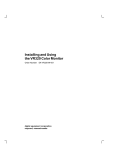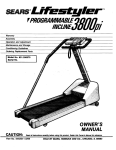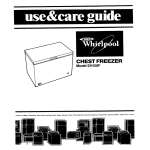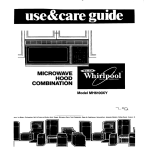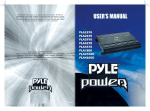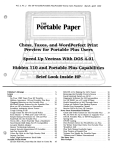Download Graco Inc. 216-119 Paint Sprayer User Manual
Transcript
Parts WARNING Before cleaning the gun nozzle or attempting to service the gun or other components, always turn off the high voltage first, then shut down paint pump and trigger gun to relieve fluid pressure. Be sure your installation complies with all applicable local codes. ALWAYS use the lowest pressure possible when flushing and use a grounded metal waste container. Grounding All components of the system, except the gun and paint hoses, must be electrically grounded. Be sure the electric power circuit is properly grounded. Be sure your gun is not grounded. Use un$rbunded paint hoses to gun only, and be sure your supply pump and the object you are painting are-grounded. When flushing, avoid conductive solvents, if possible. Be sure to turn off H.V. Power Supply before flushing, and to remove all solvent from gun before turning on high voltage. r Operating Never use or store solvents in the spray area. All conductive objects within 10 ft (3 m) of the gun must be electrically grounded. NEVER IMMERSE THE SPRAY GUN IN SOLVENT OR OTHER LIQUID. The object being coated must be grounded. Keep work hangers and conveyor equipment clean so work pieces are well grounded. How The Elecnostatic Automatic Air Spray Gun Works A transformer supplies high voltage current through the cable to the gun’s ionizing electrode, where the electrostatic field is developed. The pump supplies paint Be sure your installation complies with Federal, State and local codes for the installation of electrical apparatus in a Class 1, Divisions 1 and 2 Hazardous Location. The particular type and size system for your operation will have to be custom designed for your needs. For a correctly sized system, contact the Grace Finishing System Division, Franklin Park, Illinois. Mount the gun on an insulated stationary support or reciprocator arm. The spray gun has a mounting hole to fit a 0.5 in. (13 mm) diameter rod. Use a mounting fixture which allows adjustment of the spray pattern direction and distance from the work. through the hose and gun, where it is electrostatically charged as it passes the ionizing electrode. The charged paint is attracted to the grounded work piece, wrapping around it and coating surfaces indirectly. hose from the solenoid valve to the gun’s l/4” npt(m) cylinder air inlet. Connect an air supply line to the l/4” npt(m) atomizing air inlet. BEFORE CONNECTING FLUID LINES, BLOW THEM OUT WITH AIR AND FLUSH WITH SOLVENT. BE SURE THAT THE SOLVENT YOU USE IS COMPATIBLE WITH THE MATERIAL TO BE SPRAYED. Connect a fluid hose to the paint supply pump’s outlet and to the gun’s 3/8 npsm fluid inlet. Install fluid tip in gun. Be sure fluid pressure is relieved and high voltage turned off before installing tip. Recommended Hose Sizes (General Purpose) MATERIAL O-10 ft (O-3 m) lo-35 ft (3-l 1 m) 35-100ft ill-30m) 100-200 ft (30-61 m) I l/4” 3/8” l/2” 3/4” ID ID ID ID I l/4” ID 5/16” ID 3/4” ID I AIR Install a normally closed, 3-way air solenoid valve in the cylinder air supply line. BEFORE CONNECTING AIR LINES BLOW THEM OUT TO REMOVE METAL CHIPS AND OTHER FOREIGN PARTICLES. Connect an air Adjust the system’s control device so the gun starts spraying just before the spray meets the workpiece, and stops as soon as it is past. The gun requires a minimum of 30 psi (2 bar) air pressure to the cylinder. Fluid Control Adjust the fluid flow to the proper rate, using a fluid 2 307434 I O-50 ft (O-15 m) 50-100 ft (15-30 m) 100-200 ft (30-61 m) regulator installed in paint line. It is best to adjust flow rate with a fluid regulator. Spray Pattern Control Turn air adjusting screw (36) counterclockwise for a wide flat spray pattern or clockwise to decrease to a round pattern. NOTE: When increasing to a wide, flat pattern, increase supply of fluid to gun to maintain same coverage over larger area. Direction of changed by the desired TIGHT. DO spray pattern (horizontal or vertical) is loosening lock ring and turning air cap to position. TIGHTEN LOCK RING HAND NOT OVERTIGHTEN. Normal Spray Pattern .: >: Proper adjustment will grve a spray pattern shaped ## Iike this. $ $::i : . 0 Improper Spray Patterns Heavy on top or bottom, right or left. Caused by paint buildup on air cap or fluid tip, partially plug- ged air holes or fluid tip. To remedy, clean the cap or tip. &$ Heavy in the center. Caused by too much, or too @$ thick material. To remedy, reduce flow by re0 <is? ducing fluid pressure or thinning the paint. Split pattern. Caused by insufficient paint, or too much air pressure. To remedy, increase fluid pressure or reduce air pressure. Connect high voltage cable to the high voltage adapter (44. When all adjustments are made, -trigger air, atomizing air, fluid pressure, and fan pattern,-you can turn on the high voltage and begin operation. Care of Gun Good housekeeping is important. Clean the gun and work area daily. A buildup of conductive residue on either exterior or interior surfaces of gun may interfere with proper operation. Flush out the gun with an approved solvent at the end of the work day. Wipe the outside of the gun with an approved gun cleaner. Remove the air cap and clean it. If ionizing wire of needle (41) is bent after cleaning, straighten wire so that it is centered in fluid stream. For an approved solvent or gun cleaner, see your local supplier or Grace Branch. Also, refer to OSHA 29 CFR 1910.107(g)(5). Cleaning After each spraying operation, turn off the high voltage power supply, and solvent flush until all remaining paint is removed from hose and gun. If air cap needs cleaning, remove and soak in clean compatible solvent (not over 15 minutes) and scrub with a fine bristled brush. To clean out holes in air cap, use a toothpick or other soft implement. Never use metal instruments to clean holes in air entire gun in I WARNING I Make sure the H.V. power supply electricity is turned off before connecting or drsconnectrng the high voltage leads at guns or junction arm. TROUBLESHOOTING CHART WHAT’S WRONG Fluid needle packing nut leakage Air leakage from front of gun Fluid leakage from front of gun Spitting or fluttering spray Defective spray pattern “Orange Peel” finish Streaks in finish Runs or sags in f Excessive spray Fluid won’t corn must be turned off. Before removing air cap or spray tip, shut down paint pump and trigger gun worn packing Air valve not seating properly Fluid needle not seating properly Fluid low Loose fluid tip or damaged seat Loose air cap, dirty or damaged fluid nozzle or air cap Needle worn or damaged Too much air pressure Insufficient air pressure Poorly mixed and/or strained fluid Fluid thinned out too much Improper thinner Clean,lubricate,service Loosen packing nut, clean or replace Check fluid supply Tighten,clean,replace Tighten,clean,clear replace Replace Use least necessary Increase air pressure Properly mix and strain Properly thin fluid Use proper thinner 307434 3 should be taken when starting threads. Applied vide you with years of durability and efficiency These working parts require periodic replacement: 1. Air cap (7). 2. Fluid tip (6). 3. Needle, fluid (41). Removing Fluid Tip To remove fluid tip (6) for cleaning or replacement, remove the ring nut (8) and air cap (71, turn off the atomizing air, trigger the gun to release needle pressure on the tip. Remove the tip with a wrench. Replace with the needle triggered to the rear. When replacing air cap (7) on the gun, be sure the wire electrode coming from the needle (41) is centered in the air cap center hole. The best method is to slide the air cap onto fluid housing (51, making sure that the wire goes through center hole of air cap, then tighten ring nut (8), onto barrel (42) allowing air cap to be drawn up evenly on the fluid tip. Check alignment of ionizing wire in the fluid stream. Removing Fluid Tip Housing If the housing (5) is removed, the o-rings (2) should be replaced and the housing firmly seated. The housing must be torqued no more than 15-20 ft-lb (20 N-m), or plastic threads may become stripped. Lubricate with petroleum jelly new o-rings on housing before replacing in gun barrel. NOTE: Fluid tip (6) must be removed from housing before replacing to avoid damage to ionizing wire. Replacing Fluid Needle Turn off the atomizing air and fluid, trigger the gun to release needle pressure on the tip. Remove ring nut (8) and air cap (7). Remove fluid tip (6) with a 7/16 in. wrench. Remove nut (19) and screw (31) from the rear of the gun. With a long nose pliers pull out needle extension (46), nut (291, nut (301, spring (331, and needle (41). Unscrew needle (41) from extension (46). (Pliers maybe necessary as Loctite is used on threads.) Install new needle (411, applying Locrite no. 290 or equivalent to threads to prevent needle from coming loose during operation. Reassemble needle into back of gun using extreme care. Ionizing wire must remain straight as it passes through rear actuator packings (18). After needle is assembled in the gun, replace fluid tip (6) and rear spring (33) and spring (341, along with adjusting screw (311, locknut (19) and air cap (7). For adjustment see Replacing Fluid Needle Extension. 4 307434 Replacing Needle Guide Needle guide (47) is pressed into rear of fluid housing (5). Remove fluid housing and press out needle guide. When replacing be sure internal chamfered end faces rear of fluid housing. Replacing Fluid Needle Extension Remove needle (see Replacing Fluid Needle). When replacing extension (46); locknut (29) and needle adjusting nut (30) must be readjusted on needle extension. Push needle (41), needle extension (46) and piston (38) fully forward, and turn the adjusting nut (30) all the way into the piston. Remove needle assembly from piston, turn adjusting nut two turns counterclockwise, and tighten locknut (29). This adjustment provides atom izing air just before the fluid needle is engaged and after seating. Replacing Fluid Packing The fluid packing (23) is replaced when the needle (41) is removed. Remove the packing nut (22) then pick out the packing and replace. Replace the packing nut. Insert the fluid needle, tighten the packing nut and apply pressure on the packing to a firm seating. Do not overtighten. The fluid needle should move without binding. When the gun is completely assembled and fluid pressure applied, the packing nut may be tightened to correct a slight leak. Removing Gun Barrel It is seldom necessary to remove the gun barrel (42) from the gun body (37). When necessary, this is accomplished by unscrewing the gun coupling (8) and carefully lifting away from the gun body. Inspect o-rings (I and 4) and replace if necessary. To line up guide pin in barrel with hole actuator assembly keep indicator detent intop of barrel lined up with top of actuator. Replacing Cylinder Adapter The cylinder adapter (43) should not be removed unless damaged. Replacing Electrode Stem of Fluid Needle If electrode stem (48) of fluid needle (41) needs replacement, first unscrew electrode stem from fluid needle extension (46). Unscrew setscrew, and remove old electrode stem. Insert new electrode stem and replace setscrew. Reassemble fluid needle (41) to fluid needle extension Ma ELECTROSTATIC AUTOMATIC AIR SPRAY GUN Model 216-119 47 CHAMFERED END TOWARD NEEDLE Ref No. 39 Air Adjusting Screw Assy includes items / 26-26 and 36. HAND TIGHT (27-34 N-m) Torque to 15-19 ft-lb C20-25 N-m) I REF PART NO. 103649 +103-823 722-615 +155-685 172-191 177-062 177-033 176-387 176-388 217-013 Series”B” l 103338 l 103-523 “103-524 “103-610 “103649 “160-240 162-782 “174-099 171333 171332 “106901 169-870 176-773 105-456 *X8-1 10 170-242 170-243 L46 DESCRIPTION PACKING, o-ring; viton PACKING, o-ring; nitrile rubber ELBOW, l/4 npt(m) x x l/4 npsm(f) swivel PACKING, o-ring; nitrile rubber HOUSING, fluid tip FLUID TIP, See chart for optional tips AIR CAP, See chart for optional air caps RETAINING RING RETAINING RING AUTOMATIC AIR VALVE ASSY. includes items 1 l-40 and 52 PACKING, o-ring; viton : GASKET; copper . GASKET; copper . PACKING, o-ring; viton . PACKING, o-rina: viton PACKING. v-blozk; leather : LOCKNUi . STUD, coupler NUT, packing : NUT, packing PACKING, needle; PTFE : ADAPTER, air inlet; l/4” npsm HOUSING, spring : WASHER . O-RING, polyurethane NUT, lock; needle : NUT, needle adjusting *Included in Repair Kit 215697. (See back page). PART NO. 170-244 170-249 724391 170-253 171-722 217-198 21 O-743 “208-718 217-199 171-052 “215-695 214-919 724306 728-136 176390 176-513 215696 177-122 177-121 177-142 DESCRIPTION . SCREW, needle adjusting . CYLINDER, air piston . SPRING, compression . SPRING, compression HOUSING, valve : SCREW, air adjusting . HOUSING, valve PISTON, air : AIR ADJUSTING SCREW ASSY. includes items 26-28,36 (part of ref no. 10) . GASKET, PTFE (part of ref no. 10) NEEDLE, fluid BARREL ADAPTER, cylinder ADAPTER, 3/8-16 x 5/8 NPT NEEDLE, ext-fluid GUIDE, needle STEM, electrode (replacement kit of 25) STEM, coupling STEM, fluid WRENCH *Recommended “tool box” spare parts. Keep on hand to reduce down time. Order parts by name and number. Always give the model number and series letter of the assembly for which you are ordering. 307434 5 AIR CAP CONSUMPTION AND FLUID TIP FLOW RATE CHART 5 Approximate Pattern Length Air Cap 254 mm (10 in) Part Number from gun Air Consumption ma/min @ 2.06 bar (CFM e, 30 PSI) . / 177-666 177-d 177461 177463 Fluid Tip Part No 177532 355-710 591-1182 la351479 6-18 12-24 20-40 3550 1 mm 1.2 mm 1.5 mm 1.8 mm fO.040 in) (0.047 in) (0.060 in) (0.070 in) Description 177-033” 381-432 mm (15-17 in) 0.266 (9.5, Round end pattern, excellent atomization for automatic and hand gun high production. Medium viscosity materials 19-30 sec. No. 2 Zahn cup - metallics, lacquers and enamels. x x x 177-034 330361 mm (13-15 in) 0.236 (8.5) Round end pattern, very good atomization for medium automatic hand gun production. Medium viscosity materials 19-30 sec. No. 2 Zahn cup - primers, lacquers, enamels, sealers X x x 177-036 381432 m m (15-17 in) 0.28 (10) Tapered end pattern, excellent atomization for heavy and high solid material. High viscosity materials over 28 set No. 4 Zahn cup - high solid lacquers, enamels, epoxies and urethanes. x x x 177-037 279-330 m m (11-13 in) Round end pattern, good atomization for low production. Low viscosity materials 1522 set No. 2 Zahn cup - stains, primers, sealers and lacquers. 177439 356-406 mm (VI-16 in) Tapered end pattern, very good atomization for heavy viscosity material over 28 set No. 4 Zahn cup - Water-Base and Frit materials, acrylics, alkyds, vinyl, enamels and lacquers. x x X FLOW Rate ml/min oz/min ,Fluid Tip Size X ‘Standard on Model 216-119. The Equivalence Chart is designed to update old style guns with Fluid Tip and Air Cap part numbers no longer available, to current Fluid Tip and Air Cap part numbers. The left side of the chart identifies old style guns with the Fluid Tip and Air Cap part numbers which are no longer available. The right side of the chart gives the equivalent, current Fluid Tip and Air Cap part number that should be ordered when replacing parts. 6 307-434 EQUIVALENCE CHART OLD GUN NEW GUN Part Number Fluid Nozzle Orifice Size Air Cap Part Number Fluid Nozzle Orifice Size Air Cap 214-918 172-834 0.028 172-841 216-119 177-060 0.040 177-033 ;; i-i; 172-835 0.040 177-062 0.047 172-836 0.060 177-061 0.060 177-063 0.070 172-842 172-318 171-630 177-034 177-037 177-033 177-034 177-036 177-037 177-033 177-034 177-036 177-039 177-036 m-p39 ACETONE .05 MEG. 0.6 TEXTILC SPIRITS 1.06 BENZENE 1.2 TRICHLOAETHYLENE ETHYL ACETATE 0.46 MEG. I I METHVL 0. RES. MEK .05 MEG. ALCOHOL SC-1 soLvcSSodo TOLUOL 1.NITRO PROPANE .-_-. . -----..-- r METHYL AMYL ACETATE TURPENTINE NONE 1A 29’ 1.5 35 1.6 40’ 2.5 a 2.7 41 3.0 do 3.6 55 11.6 99 11.6 120 I1 3 110 14 AMYL ALCOHOL .06 MEG. SC.106 SOLVESSO.lW ETHYL CELLO. -- .oll _____^ SOLVt MLlJ. I I I DIACETONE .14 MEG. I DEPTINE MINERAL SPIRITS I I I BUTVL CELLOSOLVE 0.8 TO .19 MEG. I OOORLESS MIN. ERAL SPIRITS CVCLO HEXANOL 2.6 MEG. SC.150 SOLVESSODOWANOL DPM .03 MEG. I I 1 H N E OIL <s 1.3 0.6 TO 36 MEG. METHYL CELLO. SOLVE .02 MEG. I o* 29 ETHYL ALCOHOL D2 MEG. SOPROPVL ALCOHOL D 1. MEG t 15 < I I I I I I ISOPMORNE .07 MEG. I I I I 910 19 116 21 107. 29 115 29 155 33 120. 3sl 104. 50 166 66.2 130. 72.5 154 96 152. 116 165 193 205 -1 176. 750 206. , SHELLY)J EUTVL CARBITOL RESISTANCE MEASURED WlTti GRACO PROBE AND METER. LOW RESISTANCE, OR POLAR. SOLVENTS MEASURE NORMALLY LESS THAN HIGH RESISTANCE. OR NONPOLAR SOL VENTS MEASURE S”AOE,, AREASSHOW HlGli RESISTANCE - N-BUTYL ACETATE. AMYLAQTATE. - - TAG CLOSED CUP 1 MEG INFINITY. 307434 7 DIMENSIONAL DRAWING , * ,. . . 0.5” (13 mm) DIA MOUNTING ROD HOLE MAX WIDTH 1.31” (33.3 mm1 FLUID INLET TECHNICAL DATA ACCESSORIES (Must be purchased separately) STRAINER (AIR OR PAINT) 202-271 Uses the following filter screen: 157-332 (40 mesh) 156-967 (60 mesh) cr -’ 156-939 (100 mesh) 6 cd cdl v Maximum operating voltage: Maximum air & fluid working pressure: Minimum air cylinder operating pressure: Fluid inlet: Atomizing air inlet: Cylinder air inlet: Weight: 100,000 volts 100 psi (7 bar) 30 psi (2 bar) 3/8 npsm(m) l/4 npt(m) l/4 npt(m) 3 lb. 2 oz. (1.4 kg) H-V CABLES 724-410 For stationary mounting, 2 ft (610 mm) lg 727-997 For reciprocator mounting, 15 in. (381 mm) Ig THE GRACO WARRANTY REPAIR KIT 215-697 (must be purchased separately). Consists of: Ref No. Q;Y. s 1 1 1 11 ii 15 16 This warranty is conditioned upon the prepaid return of the equipment claimed to be defective for examination by Grace to verify the claimed defect. If the claimed defect is verified, Grace will repair or replace free of charge, any defective parts. The equipment will be returned to the original purchaser transportation prepaid. If inspection of the equipment does not disclose any defect in workmanship or material, repairs will be made at a reasonable charge and return transportation will be charged. : ; ii 28 38 Grace Inc. warrants all equipment manufactured by it and bearing its name to be free from defects in material and workmanship under normal use and service. This warranty extends to the original purchaser for a period of 12 months from the date of purchase and applies only when the equipment is installed and operated in accordance with written factory recommendations. This warranty does not cover damage or wear which, in the reasonable judgment of Grace, arises from misuse, abrasion, corrosion, negligence, accident, substitution of non-Grace parts, faulty installation or tampering. : 1 ELECTRODE KIT 215-696 Consists of (25) 177-123 Electrode KIT, REPAIR, GUN (FAN VALVE) 215-506 Ref No. 27 28 Qty. si : : THIS LIMITED WARRANTY IS EXCLUSIVE, AND IS IN LIEU OF ANY OTHER WARRANTIES (EXPRESS OR IMPLIED) INCLUDING WARRANTY OF MERCHANTABILITY OR WARRANTY OF FITNESS FOR A PARTICULAR PURPOSE AND OF ANY NONCONTRACTUAL LIABILITIES INCLUDING PRODUCT LIABILITIES BASED ON NEGLIGENCE OR STRICT LIABILITY. EVERY FORM OF LIABILITY FOR DIRECT, SPECIAL OR CONSEQUENTIAL DAMAGES OR LOSS IS EXPRESSLY EXCLUDED AND DENIED. EQUIPMENT NOT COVERED BY GRACO WARRANTY. Accessories or components of equipment sold by Grace that are not manufactured by Grace (such as electric motors, switches, hose, etc.) are subject to the warranty, if any, of their manufacturer. Grace will provide purchaser with reasonable assistance in making such claims. Factory Branches: Atlanta, Dallas, Detroit (Southfield), Los Angeles, West Caldwell (N.J.1 Subsidiary and Affiliate Companies: Canada; England; Switzerland; France; Germany; Hong Kong; Japan GRACO INC. P.O. BOX 1441 MINNEAPOLIS, MN 55440 PRINTED IN U.S.A. 307434 8-80








